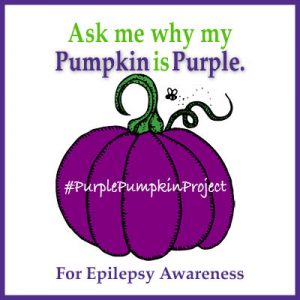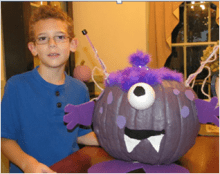In 2012, a grassroots initiative to raise epilepsy awareness was started by Ron Lamontagne in Connecticut. Since then, the Purple Pumpkin Project has taken on a life of its own. His hope is that people will reach out to their local Epilepsy organizations to host PPP events and continue raising awareness.
We love the idea and the spirit that comes with it and so this year, we at Epilepsy Toronto will be painting our pumpkin purple and we are are encouraging our members to do the same and to share their photos.
If you post a photo of your purple pumpkin creation to Facebook, Twitter or Instagram, please tag us at @EpilepsyToronto as we’d love to share your photos. And don’t forget to hashtag it too, #PurplePumpkinProject.

Why is Ron’s pumpkin purple?
 Ron’s youngest son was diagnosed with epilepsy in 2009 at the age of four. Since the diagnosis, Ron has seen how epilepsy impacted his son. Although he appears like an average kid on the surface, his son has experienced major challenges academically, physically and socially. Additionally, the misperceptions and fear about epilepsy have impacted relationships in the family.
Ron’s youngest son was diagnosed with epilepsy in 2009 at the age of four. Since the diagnosis, Ron has seen how epilepsy impacted his son. Although he appears like an average kid on the surface, his son has experienced major challenges academically, physically and socially. Additionally, the misperceptions and fear about epilepsy have impacted relationships in the family.
Although Ron has been outspoken about the challenges his son faces, many people still choose to keep their seizures private. By raising awareness, Ron hopes to support those people and increase overall awareness of epilepsy. *
*For more information see this full story on the Epilepsy Foundation website
Why is your pumpkin purple?
When someone asks, what will you tell them? Do you have a personal reason for raising epilepsy awareness – perhaps you are living with seizures, or perhaps someone you love is; or maybe you have in the past? Whatever your reason, we hope you will share your personal story with those interested in learning more about your purple pumpkin. But here are also some facts about epilepsy you may also want to share:
• Approximately one per cent of the population, about 300,000 Canadians, have epilepsy
• Approximately 40,000 individuals in the GTA have epilepsy
• The cause of epilepsy in 75 per cent of children and 50 per cent of adults affected are unknown
• Epilepsy can strike anyone at any age
How to make your pumpkin purple?
1)Choose your pumpkin. A good pumpkin for painting has a smooth, even surface with no bruises, scratches, or blemishes. Pumpkins with light or very light or shallow ribbing will have the smoothest surfaces.
2)Clean and dry your pumpkin. Gently remove any dirt or grime using a dampened paper towel or a baby wipe. Use a soft, dry cloth to thoroughly but gently dry your pumpkin. Avoid brushing the pumpkin with a hard brush because you might bruise or scratch your pumpkin or just damage the skin.
3)Take care not to get the stem area (top) or the blossom end (bottom) of the pumpkin wet. This can cause the pumpkin to rot.
Use an acrylic paint to paint the pumpkin. If you have other paint at home but aren’t sure if it’ll work on the pumpkin, test it out on a small part of the pumpkin to see if it sticks first.
4) You can use any tool you like to paint: paintbrushes, cotton swabs, sponges, or cotton balls. Keep a damp cloth at your side to quickly clean off any mistakes.
Paint tip: You can also try spray paint and chalkboard paint!
Bonus Tip:
Apply a sealer (optional). Though this is optional, applying a sealer to the pumpkin’s surface before painting will help the paint better adhere to the surface. Purchase a craft-grade sealer at a hobby or craft store. Sealers are available in either aerosol cans or squeeze bottles, according to your preference.
Use a brush to apply a liberal coat of sealer evenly to the entire surface of the pumpkin, and allow to dry thoroughly!


